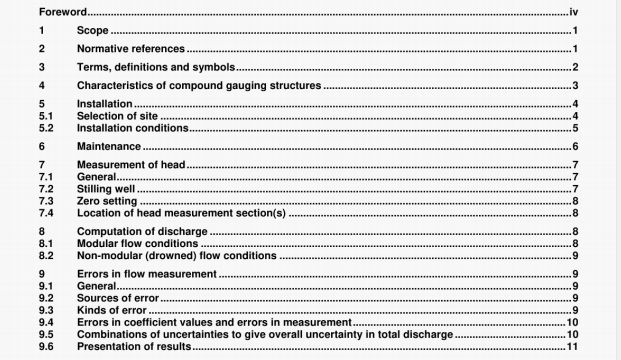ISO 14139 pdf download – Hydrometric determinations- Flowmeasurements in open channels usingstructures -Compound gauging structures.
Research has shown Thai the total head level can be assumed constant over the full width of a compound flow- measuring structure and that it can be obtained by adding to the observed waler level the velocity head appropriate to the individual section at which the water level is observed. Thus the bas’s of the method of computing the total discharge over a compound structure is to calculate the total head level at the individual section at which the water level is measured, as if it were a simple non-compound structure, and to use the same value of total head level to calculate individual discharges at other sections. Successive approximation or coefficient of velocity techniques are applied at the section of the structure where the water level is recorded to convert gauged to total heads, Discharge equations in terms of total heads are used at other sections of the compound structure and no conversions are required. An example calculation is given in annex C.
8.2 Non-modular (drowned) flow conditions
When a compound structure is designed to operate in the non-modular flow range, a triangular profile or flat-V weir with a crest tapping shall be used in those sections of the compound weir that are ldcely to drown. For trapezoidal profile weirs. Parshall flumes, streamlined triangular weirs and V-shaped broad-crested weirs, only one gauge well is required in the downstream channel,
Upstream total heads are determined as for the moduLar flow case bul discharges at those individual sections of the compound structure that are drowned are obtained by considering both the upstream total head and the crest- tapping pressure or downstream water level. An example calculation is given in annex C.
9 Errors in flow measurement
9.1 General
The total uncertainty of any flow measurement can be estimated if the uncertainties from various sources are combned. The assessment of these contributions to the total uncertainty will indicate whether the rate of flow can be measured with sufficient accuracy for the intended purpose. This clause Is intended to provide sufficient information for the user of the International Standard to estimate the uncertainties of measurements of discharges.
The error is the difference between the true rate of flow and that calculated in accordance with the equations in the appropriate standard for the particular structure used for calibrating the flow-measuring structure (which is assumed to be constructed and Installed in accordance with this International Standard). The temi uncertainty Is used here to denote the deviation from the true rate of flow within which the measured flow is expected to lie some 19 times out of 20 (with 95 % confidence limits).
9.2 Sources of error
The sources of error in the discharge measurement f or each individual section of the compound structure are as given in the errors sections of the International Standards relating to the appropriate type of structure (see B. 1). Additional errors arise due to the method used for estimating water levels or total head levels at individual sections. when (as is usual) these are not measured separately at each section. Available evidence is limited, but it suggests that the percentage uncertainty in discharge, X. associated with transposing upstream water levels or total head levels is random, with a magnitude within the range of ±5%. In particular cases, more reliable estimates can be made of this value by making field or laboratory observations. For cases involving drowned flow, hub information is available about the possible value of Xd the additional uncertainty in discharge associated with transposing downstream water levels or total head levels, which is likely to be of the order 04± 10%.
9.3 Kinds of error
9.3.1 Errors can be classified as random or systematic, the former affecting the reproducibility (precision) of measurement and the latter aflecting its true accuracy.
ISO 14139 pdf download – Hydrometric determinations- Flowmeasurements in open channels usingstructures -Compound gauging structures
